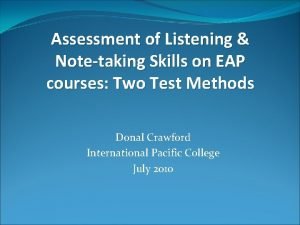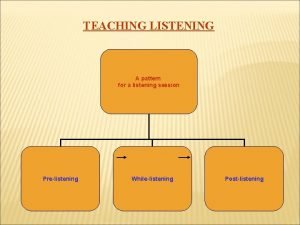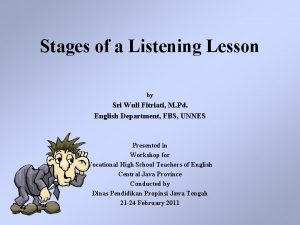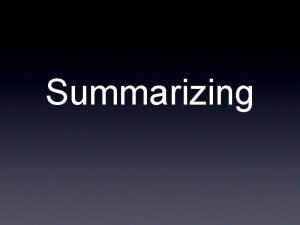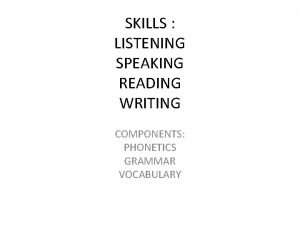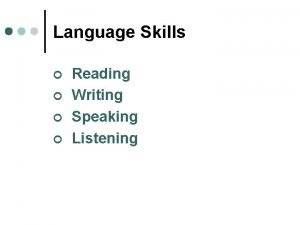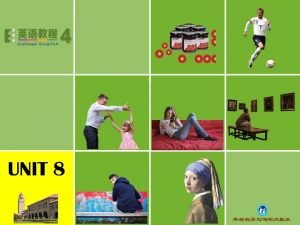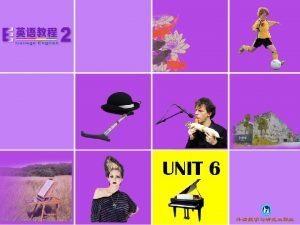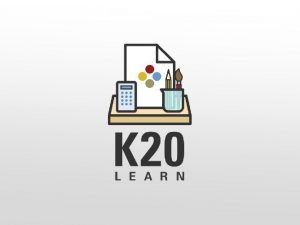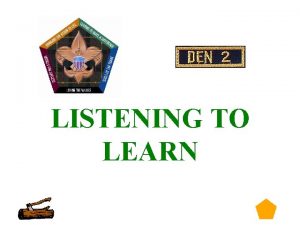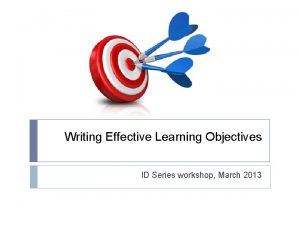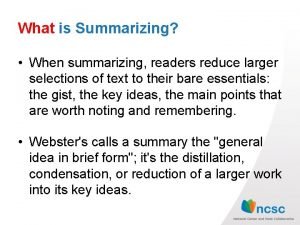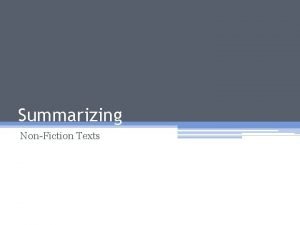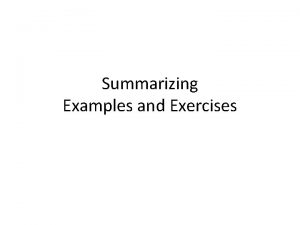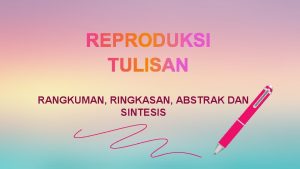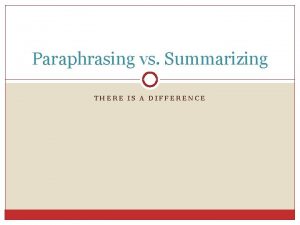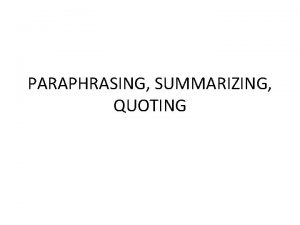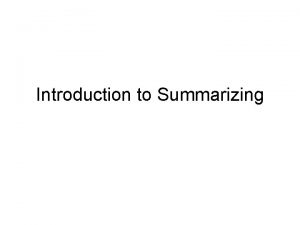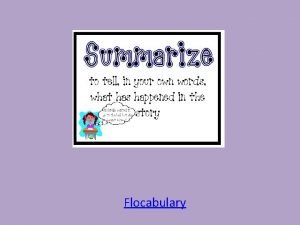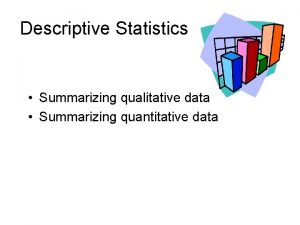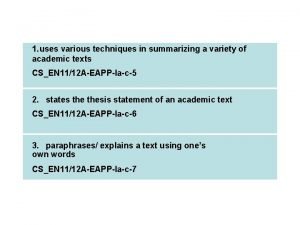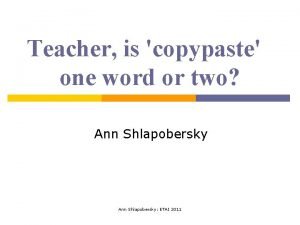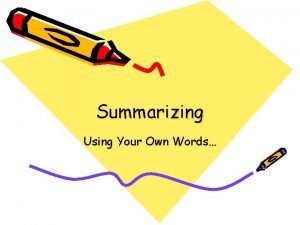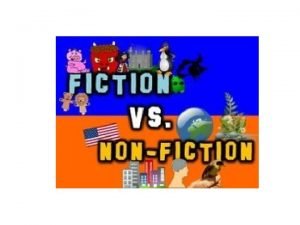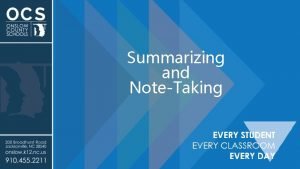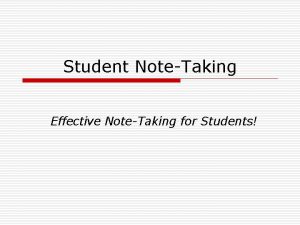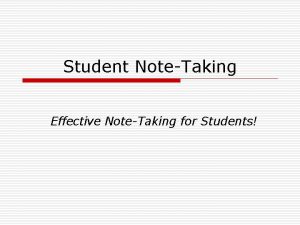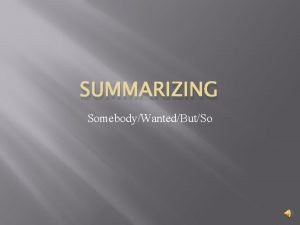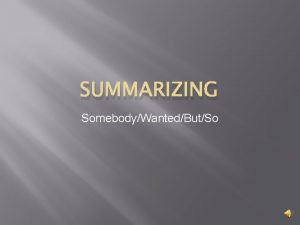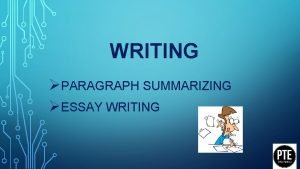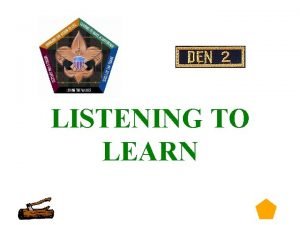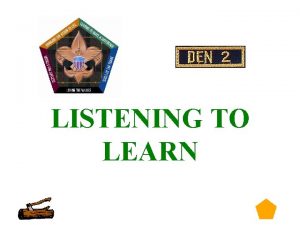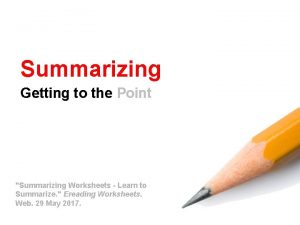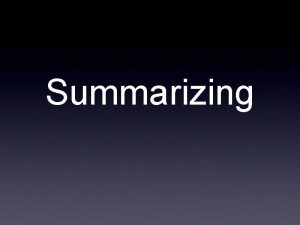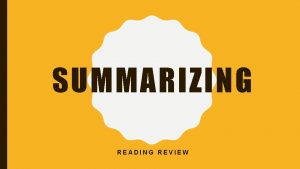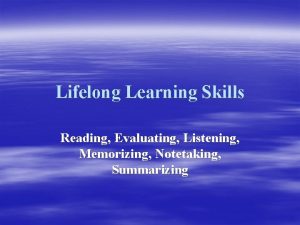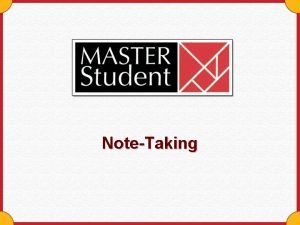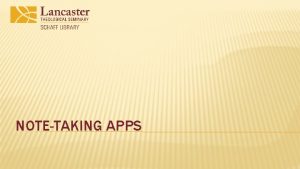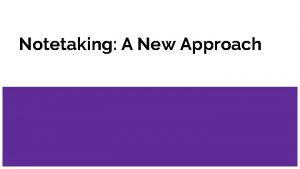SUMMARIZING NOTETAKING READING LISTENING WRITING TO LEARN Session





































- Slides: 37

SUMMARIZING & NOTE-TAKING READING, LISTENING & WRITING TO LEARN Session #1 Note. Taking

The Why? • Studies show that your achievement will increase by 34% in all content areas.

Let’s Learn Like • Seek to “discover” history. Historians • Read like witnessing the event. • Read like a lawyer making a case. • Ask the purpose of the text. • View text as man-made with a view of events. • Assume bias in text. • Consider word choice and tone. • Compares text to judge different, perhaps opposing accounts of the same event or topic.

Taking Notes • Taking more notes is better than fewer notes. • Writing down every word my teacher tells me to write down is ineffective because it does not allow time for me to process the information.


Which strategy will work best for you? • Cornell Notes • Note-Taking System for Learning • T-List • Graphically-Organized Notes

https: //www. youtube. com/watch? v=4 v. Os. VKWey. AA https: //www. youtube. com/watch? v=Lu 7 WM_fm. R 1 k

Cornell Notes Name: Date: Class Period: • Write your name, date, class, and period in the upper right hand corner (see above). • Write the topic of the notes (ex. WWII, Cells, Nouns, etc. ) on the top line (see above).

Cornell Notes • Page setup Name: Date: Class Period: • Draw a horizontal line about five lines up from the bottom. • Draw a vertical line down the page about one third of distance from the left.

Cornell Notes • • Main Idea • • Key Question • (after notes • Name: Date: Class Period: Key words & ideas Important dates/people/places Repeated/Stressed Info Ideas/brainstorming written on are board / overhead projector completed) • Info from textbook/stories • Diagrams & Pictures • Formulas

Student Example

Cornell Notes • Helpful Hints for Straight A Notes Name: Date: Class Period: • Abbrev. , Paraphrase. • Use symbols (arrows, circles, underlining) or highlighting to emphasize important ideas and relationships. • Skip lines between ideas. • Within 24 hours, review notes and develop study questions on the left side. • Be aware of teacher clues. *

Teacher Clues • How do I know if what the teacher says is important? Name: Date: Class Period: • Repetition or stressed inflection • Voice gets louder/softer or faster/slower • Writing on the board or overhead • “This will be on the test. ” • Gestures (hand/arm movements) • “This is important. ”

So, what about the bottom of my paper? What belongs in the bottom space? Name: Date: Class Period: • Summary - review notes as soon as possible after class and write a summary in your own words about the main ideas. Are there any gaps in your understanding? (see next point) • Questions for the teacher. • Doodles - down here they won’t get in the way of the important stuff. Summary, questions, doodles

Abbreviation Exercise Abbreviate the following lines so they still make sense Name: Date: Class Period: • Hippocrates, a Greek who is considered to be the Father of Medicine, was born on the island of Cos in 460 B. C. • George Washington was not, in a sense, America’s first president. • Mark Twain fell in love with Olivia Langdon. They married in 1870 and moved to Hartford, Connecticut.

Abbreviation Exercise Possible Answers Name Date Class Period • Hippocrates (Gr. ) Father of Med b. Cos 460 B. C • G. Wash. Not Am’s 1 st Pres. ? • Twain - Olivia Langdon m. 1870 to Hart Conn

Note-Taking System for Learning

Recording 1) Write down the main ideas and supporting details in outline form. 2) Leave space between the main ideas as needed for future notes and additions. Title I. Main Topic A. Important Subtopic 1. Detail a. Sub-detail b. Sub-detail c. Sub-detail 2. Detail 3. Detail a. Sub-detail b. Sub-detail B. Important Subtopic II. Main Topic A. Important Subtopic 1. Detail a. Sub-detail b. Sub-detail c. Sub-detail 2. Detail

Organizing 1) Read through notes. 2) In the left margin, create labels in the left margin that identify the main topics included in the notes. 3) Highlight and/or label according to categories you create or use one of these: Social Political Religious Intellectual Technological Economic Political Intellectual Religious Art Technological Economic Social Political Economic Religious Social Intellectual Art Competencies: § History § Geography § Government § Economics

Organizing 1) Highlight and/or label according to categories you create or use one of these: Social Political Religious Intellectual Technological Economic Political Intellectual Religious Art Technological Economic Social Political Economic Religious Social Intellectual Art Competencies: § History § Geography § Government § Economics Description Illustration People Significance Author Place and Time Prior Knowledge Audience Reason The Main Idea Significance Political Economic Geographical Social Speaker Occasion Audience Purpose Subject TONE Style Wordy Objects Relationships Details Your Position Overview Parts Title Interrelationships Conclusions

Organizing 4) Write any questions you may have and/or things you would like to know more about in the margin as well. 5) Add to your notes information from other sources (text, other books, primary sources, lecture, etc. ) about the same topic.

Studying 1) Use your notes to study. 2) The labels and information in the left margin provide a summary and overview of your notes.

T-List Main Ideas Details

T-List Organize the main ideas and details of the SS lesson on the chart below: Main Ideas • List main ideas or key concepts. • Use only two or three words. Details • Record the corresponding details that support the main ideas. • Include vocabulary words and explanations for those unfamiliar words to you. • Write in your own words – do not copy.

Graphically-Organized Notes

Timeline (Chronology)

Sequencing

Event/Characteristics (Descriptions)

Cause and Effect

History Frame CONTEXT SOMEBODY WANTED BUT SO IN THE END

Buckets

Venn Diagram (Compare and Contrast)

Central Idea & Supporting Details

Claim, Evidence & Reasoning Stool

Historical Character Map

Foldables

Technology Tools
 Listening and notetaking skills
Listening and notetaking skills Pre while post listening
Pre while post listening Pre listening stage
Pre listening stage Why is summarizing a powerful technique
Why is summarizing a powerful technique Grammar listening speaking reading writing
Grammar listening speaking reading writing Listening speaking writing
Listening speaking writing Grammar listening speaking reading writing
Grammar listening speaking reading writing Grammar listening speaking reading writing
Grammar listening speaking reading writing Pre reading while reading and post reading activities
Pre reading while reading and post reading activities Listening session template
Listening session template Kinesthetic learners definition
Kinesthetic learners definition 4-2 reading quoting paraphrasing and summarizing
4-2 reading quoting paraphrasing and summarizing Listening to learn
Listening to learn Active listening involves
Active listening involves Define critical listening
Define critical listening Receptive skills listening and reading
Receptive skills listening and reading March 2013
March 2013 St. louis
St. louis What are the aims of teaching reading?
What are the aims of teaching reading? Intensive reading characteristics
Intensive reading characteristics Edb net section
Edb net section Prerequisite of discovery in critical reading
Prerequisite of discovery in critical reading Real definition of extensive reading
Real definition of extensive reading Extensive reading
Extensive reading Ineffictive
Ineffictive What is sumarizing
What is sumarizing Nonfiction summary
Nonfiction summary Height connotes status in many parts of the world
Height connotes status in many parts of the world Jelaskan perbedaan ringkasan, abstrak, dan sintesis
Jelaskan perbedaan ringkasan, abstrak, dan sintesis Paraphrasing vs summarizing
Paraphrasing vs summarizing Try to practice paraphrasing summarizing and direct quoting
Try to practice paraphrasing summarizing and direct quoting What is summerizing
What is summerizing Flocabulary summarizing
Flocabulary summarizing How to summarize qualitative data
How to summarize qualitative data Summarizing techniques eapp
Summarizing techniques eapp Difference between summarizing and paraphrasing
Difference between summarizing and paraphrasing Basic signal words in summarizing
Basic signal words in summarizing Summarizing nonfiction
Summarizing nonfiction
